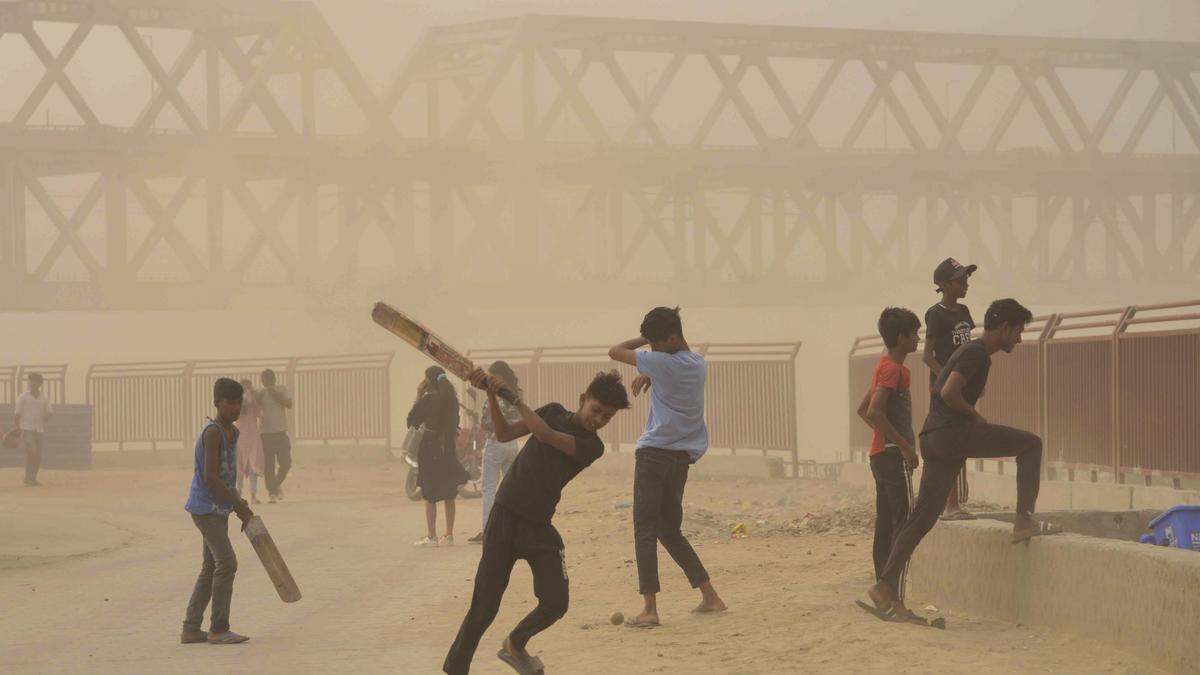Children play cricket during a dust storm, in Patna, on June 3, 2024.
| Photo Credit: PTI
Children form about 30% of India’s population, but they are invisibilised during elections. India has the largest child population in the world, yet most political parties turn a blind eye to children’s interests. What have some of the major political parties promised to shape our children’s and nation’s future, especially in terms of nutrition, education, and health?
Education
On education, the BJP’s manifesto promises to strengthen the network of PM SHRI Schools, Ekalavya Schools, and other such schools as per the National Education Policy, 2020, to make them “world class.” Strengthening a few cost-intensive model schools to provide high quality education to a few children cannot be considered as an alternative to making systemic changes to improve the public education system. In fact, recent State-wide reforms to the public education systems in Andhra Pradesh and New Delhi show that India does not need model schools in silos — it needs every government school to be a model school to effectively cater to millions of students.
The BJP manifesto also speaks of working towards a 100% Gross Enrollment Ratio (GER) from the pre-school to secondary level but does not state any concrete steps that it will take to achieve this. According to the Unified District Information System for Education, the GER from Class 1-8 is already around 100%. In secondary and higher secondary classes, the GER hovers around 80% and 57%, respectively, due to lack of systemic support. Achieving 100% GER from pre-primary to secondary school is only possible if free and compulsory education, as provided by the Right to Education Act (RTE), 2009, includes pre-primary, secondary and higher secondary classes.
The Congress manifesto promises to amend the RTE Act to to make education from Class 1-8 compulsory and free, but fails to acknowledge the importance of extending it to pre-primary — a sector with barely any regulation and oversight. The CPI(M) manifesto promises to expand the RTE Act from 3 to 18 years. The BJP does not discuss RTE at all. Further, both the Congress and DMK manifestos promise to provide financial support through scholarships or economic opportunities for children’s families to curb the dropout rates.
EDITORIAL | Promise or perish: On political parties and their manifestos
Nutrition and healthcare
On nutrition, while the BJP promises to focus on eliminating malnutrition among tribal children, the Congress promises to generally address nutritional deficiency among children. Both the parties fail to indicate any concrete measures to be taken in this regard, especially in light of the POSHAN tracker data which shows that at least 43 lakh children (0-6 years) are malnourished. The Integrated Child Development Services (ICDS), a crucial tool to counter malnutrition among children below five years, provides for a nutrition programme, nutrition and health education, and health check-up, among others. It is commendable that the CPI(M) commits to universalisation of the ICDS Scheme to cover all children from the age of 0-6 years in order to provide nutritious meals to children in all Anganwadis. The mid-day meal programme for children has proven to be effective in providing nutritious meals to children (Class 1-8). Building on its success, the Congress assures expansion of the scheme up to Class 12, while the DMK promises expansion of the Chief Minister’s Breakfast Scheme for children to aided schools (Class 1-5).
Malnourished children are vulnerable to preventable illnesses leading to higher mortality rates. The National Family Health Survey conducted in 2022 reported that India is constantly battling with chronic malnutrition in children. India is also falling short of meeting the Sustainable Development Goal of creating a world free of hunger by 2030. Access to healthcare for children remains one of the biggest challenges today. In this regard, it is commendable that the DMK promises budgetary allocations to ensure complete healthcare during the first 1,000 days of a child’s development. It also prioritises mental health by aiming to provide for mental health programmes in schools. The Congress manifesto also promises to ensure full immunisation of children within 5 years. This percentage stands at only 76% as of today. Taking a straightforward stance on health, CPI(M) assures complete coverage of basic services, such as immunisation and regular health check-ups for all children.
Some of the aspects that the manifestos could have addressed are the participation of children in democratic decision-making processes, ways to ensure safety of children in online spaces, and initiatives to prevent exploitation of children. Children are important stakeholders, a view reiterated by India’s ratification of the United Nations Convention on the Rights of the Child in 1992. However, not a single manifesto uses a “child-rights based approach”. The larger issue lies in the fact that children are not considered as separate entities by political parties. Instead, they are clubbed with ‘women’ or ‘youth’, which in effect downplays their specific needs and requirements. The two manifestos that stand out in terms of providing for children are those of the DMK and the CPI(M). Both these parties have made efforts to include a separate section on child welfare and children, thereby advocating for the rights of children.
Political parties must aim to make education, child nutrition, and health a priority in their manifestos. At the same time, voters must assess the vision and seriousness of the parties to safeguard the future of children.
Avinash Reddy Pichhili is the Co-founder of DEVISE- Developing Inclusive Education. Sneha Priya Yanappa is a Senior Resident Fellow at Vidhi Centre for Legal Policy.

